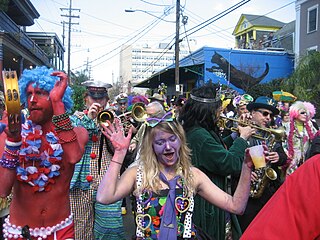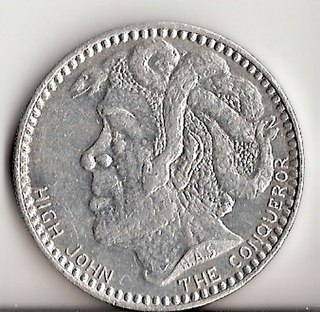
Mardi Gras is the final day of Carnival ; it thus falls on the day before the beginning of Lent on Ash Wednesday. Mardi Gras is French for "Fat Tuesday", reflecting the practice of the last night of consuming rich, fatty foods in preparation for the Christian fasting season of Lent, during which the consumption of such foods is avoided.

A krewe is a social organization that stages parades and/or balls for the Carnival season. The term is best known for its association with Mardi Gras celebrations in New Orleans, but is also used in other Carnival celebrations throughout Louisiana and along the Gulf of Mexico, such as the Gasparilla Pirate Festival in Tampa, Florida, Springtime Tallahassee, and Krewe of Amalee in DeLand, Florida with the Mardi Gras on Mainstreet Parade as well as in La Crosse, Wisconsin and at the Saint Paul Winter Carnival.

The holiday of Mardi Gras is celebrated in southern Louisiana, including the city of New Orleans. Celebrations are concentrated for about two weeks before and through Shrove Tuesday, the day before Ash Wednesday. Mardi Gras is French for Fat Tuesday, the season is known as Carnival and begins on 12th Night, January 6th, and extends until midnight before Ash Wednesday. Club, or Krewe, balls start soon after, though most are extremely private, with their Kings and Queens coming from wealthy old families and their courts consisting of the season's debutantes. Most of the high society Krewes do not stage parades. As Fat Tuesday gets nearer, the parades start in earnest. Usually there is one major parade each day ; many days have several large parades. The largest and most elaborate parades take place the last five days of the Mardi Gras season. In the final week, many events occur throughout New Orleans and surrounding communities, including parades and balls.
The Krewe of Endymion is a New Orleans Mardi Gras super krewe and social organization.

The Krewe of Orpheus is a New Orleans Mardi Gras super krewe and social organization.

The Half-Fast Walking Club is a New Orleans Mardi Gras krewe founded and historically led by Pete Fountain, until his death on August 6, 2016. Originally all on foot, in recent decades it has also featured one or two small floats. Fountain and other local jazz musicians played through much of the parade. The krewe's current route, basically unchanged since the mid-1970s, starts at 7 AM on Mardi Gras morning, at world-famous Commander's Palace Restaurant on Washington Avenue in the Garden District. The krewe then proceeds downtown on St. Charles Avenue and after a brief interlude on Canal Street, enters the French Quarter at Bourbon Street, winds around the Quarter and eventually ends up at the Monteleone Hotel in the early afternoon.
Krewe of Tucks is a New Orleans Mardi Gras krewe.

The Zulu Social Aid & Pleasure Club is a fraternal organization in New Orleans, Louisiana which puts on the Zulu parade each year on Mardi Gras Day. Zulu is New Orleans' largest predominantly African American carnival organization known for its krewe members wearing grass skirts and its unique throw of hand-painted coconuts. The club is a regular feature of the New Orleans Jazz & Heritage Festival.
KOE, formally known as the Krewe of Elvis, is a Mardi Gras parading organization that consists of members from around the world who meet in New Orleans for Mardi Gras.

Krewe of Bacchus is a New Orleans Mardi Gras super krewe.

Mardi Gras is the annual Carnival celebration in Mobile, Alabama. It is the oldest official Carnival celebration in the United States, started by Frenchman Nicholas Langlois in 1703 when Mobile was the capital of Louisiana. Although today New Orleans and South Louisiana celebrations are much more widely known for all the current traditions such as masked balls, parades, floats and throws were first created there. From Mobile being the first capital of French Louisiana (1702), the festival began as a French Catholic tradition. Mardi Gras has now evolved into a mainstream multi-week celebration across the spectrum of cultures, becoming school holidays for the final Monday and Tuesday, regardless of religious affiliation.
The Krewe of Muses is an all-female super krewe and social organization.

A mystic society is a Mardi Gras social organization in Mobile, Alabama, that presents parades and/or balls for the enjoyment of its members, guests, and the public. The New Orleans Krewe is patterned after Mobile's Mystics. The societies have been based in class, economic and racial groups. Mobile's parading mystic societies build colorful Carnival floats and create costumes around each year's themes.

Mardi Gras in the United States is celebrated in a number of cities and regions in the country. Most of these places trace their Mardi Gras celebrations to French, Spanish, and other Catholic colonial influences on the settlements over their history.

The Intergalactic Krewe of Chewbacchus is a science fiction–themed Mardi Gras krewe, religious and parade organization, that also features fantasy and horror groups, among other fandoms. Based in New Orleans, Louisiana, as of the 2019 parade, the Intergalactic Krewe of Chewbacchus has over 2500 dues-paying members who call themselves "ChewbacchanALIENs" or "Chewbs."
Krewe of Carrollton is a New Orleans Mardi Gras krewe.

Mardi Gras Doubloons are Mardi Gras throws shaped like coins that commemorate various Mardi Gras Krewes. They are typically made of aluminum and are thrown from floats in carnival parades. The first doubloons used as throws from parades of Mardi Gras Krewes date to 1960, and these early doubloons are collectible.
Krewe of Okeanos is a New Orleans Mardi Gras krewe.
Knights of Babylon is a New Orleans Mardi Gras krewe that was founded in 1939.
Krewe of Mid-City is the 5th oldest continually-parading New Orleans Mardi Gras krewe.












